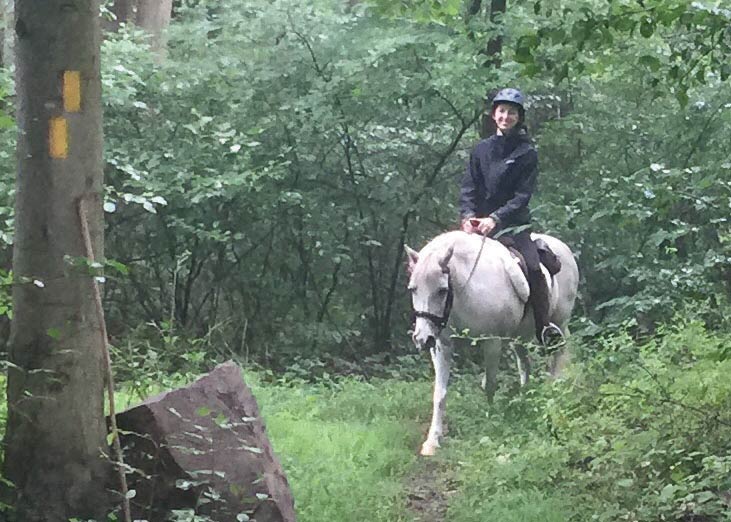 Esther Cargill riding Princess near Dutch cousin campground. Credit Sharon Cargill.
Esther Cargill riding Princess near Dutch cousin campground. Credit Sharon Cargill.
Don Newcomer frequently rides his Appaloosa mare Scarlet on the Horse-Shoe Trail, a 140-mile path that winds from Valley Forge to north of Manada Gap. His favorite section is the farthest west, just before the Horse-Shoe Trail meets up with the 2,200-mile-long Appalachian Trail. It's the most remote section, somewhat steep and a bit rocky.
“You feel like you're in the wilderness,” Newcomer said. “It's off the beaten path.”
Sharon Cargill followed the trail's yellow blazes on her ponies Princess and Peppy. She has a particular fondness for a section near Chester Springs consisting of rolling hills, woodlands and farms, where fox hunting is a favored pastime.
Riders and hikers have been enjoying the Horse-Shoe Trail since 1935, after Henry Woolman, an enthusiastic horseman, decided the mountainous section of southeast Pennsylvania was sufficiently scenic to merit a trail comparable to those he rode in the Smoky Mountains of North Carolina.
Designed for Horses
From the beginning, the trail was designed for both horseback riding and hiking; hence its name. Since its earliest days, it has been maintained by volunteer members of the Horse-Shoe Trail Conservancy. As development pressure forces frequent relocations, it hasn't been easy to keep it as a continuous pathway. There are roads in new developments named after the Horse-Shoe Trail, although the trail itself is no longer there.
While a good part of the trail now goes through parks, state forests and game lands, a lot of it still crosses private properties.
“Woolman could ride from farmer to farmer to get permission to cross their land and seal the deal with a handshake,” said Ingrid Cantarella-Fox, president of the Horse-Shoe Trail Conservancy.
“Unfortunately, that's no longer true.”
In more recent years, Conservancy members have been meeting with local townships, attempting to obtain formal easements across lands when a new developer comes in with a proposal in order to permanently protect the pathway.
The Conservancy continually tries to get more of the trail off roadways. While most of the sections which are on roads are along back roads with good shoulders, there are a few short sections along busier streets. Rerouting the trail to improve it is “an ongoing process,” Cantarella-Fox said.
For riders like Newcomer and Cargill, the trail remains a beautiful respite from their everyday lives.
“The trail has a little bit of everything, from rocky steep slopes to Jeep trails and rolling pastures,” Newcomer said.
Wildlife and Attractions
Cargill completed her end-to-end ride in sections between summer of 2016 and December 2017. Along the way she saw eagles, falcons, deer, bear tracks, wildflower fields and brilliant fall leaves. She enjoyed the history – the trail follows many of the original paths that connected iron ore furnaces, forges and the forests that provided charcoal. The trail begins in Valley Forge National Historic Park and goes past the historic Hopewell Furnace National Historic Site, among many others, some of them restored and others remaining as attractive ruins.
Other highlights along the way are St. Peter's Village, Warwick County Park, French Creek State Park, the Middle Creek Wildlife Management Area (famous for its spring migration of thousands of snow geese), the petting zoo and ice cream treats at the Pretzel Hut, Governor Dick Park and the Milton Hershey School.
Cargill found the hikers she met particularly friendly, and nobody complained about horse poop along the trail.
“People really liked to see the horses,” she said. “They would ask if they could give them carrots or apples, and if they could pet the pony.”
When Cargill rode Princess or Peppy along the Horse-Shoe Trail, she felt connected to nature and to the past.
“Some parts of this trail were used when horses were our main mode of transportation,” she said.
Cantarella-Fox said riders should make use of the trail because “number one, it's there, and number two, it can accommodate different kinds of riders.”
For more information on the Horse-Shoe Trail, go to its website at hstrail.org.
A guidebook with ten maps is available for $15 and can be ordered through the website. The book includes a list of which parking spots are large enough to accommodate a horse trailer. Anybody who would like to support the trail can become members starting at $25 annually. People interested in volunteering to maintain it, or with additional questions, can email info@HSTrail.org.
The Horse-Shoe Trail also has a Facebook Page and Twitter account.




